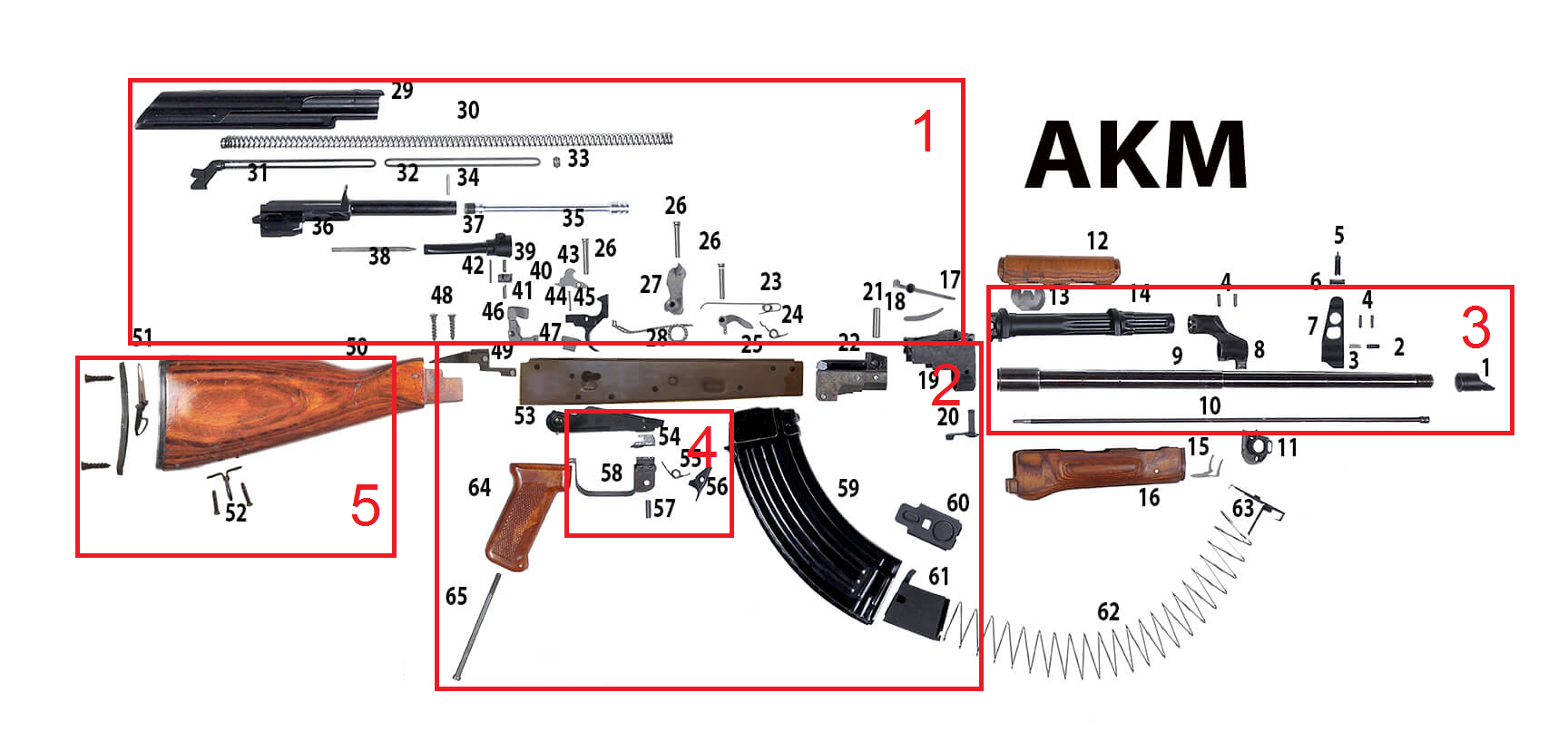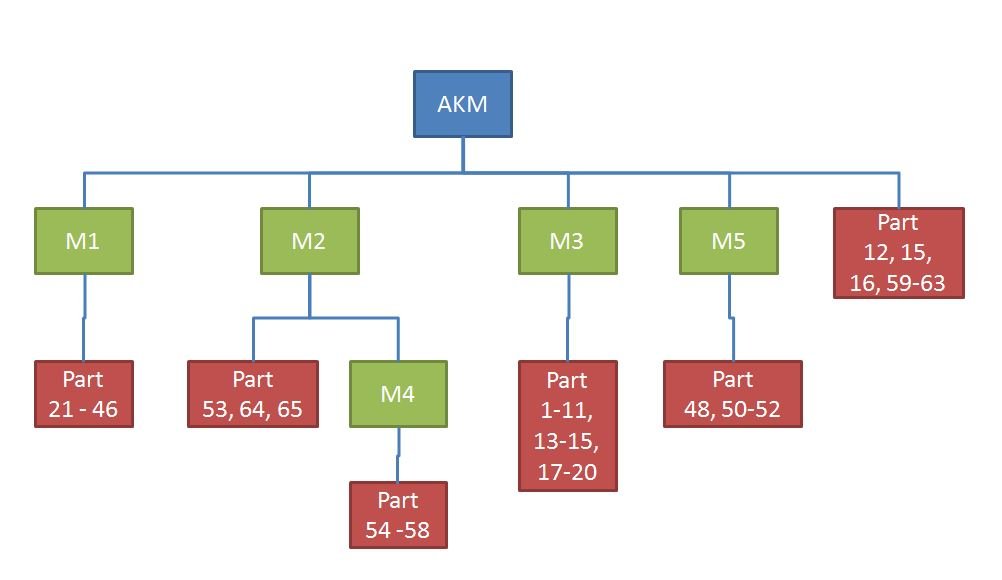Product lists are the final necessary part of your documentation.

Note: Since I come from a country where the citizens aren't free enough to own firearms I am lacking in practical knowledge and like to apologize for eventual errors. The AKM will still be used because it is a beautiful piece of technology.
Part Lists
While the engineering drawings show detailed how a part is shaped and produced, the part list gives information about all necessary parts needed for manufacturing. The normal part list lists each part with description, part number and other important information.
For a more visual example:

The AKM consists out of 65 different parts, according to this picture.
The part list has a head part with information about the project, responsible creator, date and further necessary info.
Below this is the table with a column for the row number, name, description and part number.
| Project: AKM | Name: Engineercampus | Date: 26.9.2016 | Page 1/2 |
|---|---|---|---|
| Nr. | Name | Description | Part Number |
| 1 | Slant Muzzle Break | Screwed on barrel | AK001 |
| 2 | Deter Plunger | Fixes front sight | AK002 |
| 3 | Deter Spring | Fixes front sight | AK003 |
The table categories can be enhanced to build more detailed list, three of which are named in the following.
Quantity List
A list which also contains the quantity and unit of each part. It is optimized for purchase and logistics.
| Project: AKM | Name: Engineercampus | Date: 26.9.2016 | Page 1/2 | ||
|---|---|---|---|---|---|
| Nr. | Name | Description | Quantity | Unit | Part Number |
| 48 | Stock Screw | Fixes part onto stock | 4 | Piece | AK048 |
| 49 | Fixed Stock rear trunnion | Connects stock to receiver | 1 | Piece | AK049 |
| 50 | Fixed Stock | Wood stock | 1 | Piece | AK050 |
While there is not much difference to the part list, it gives a good oversight over the amount of parts that will have to be handled. The number of norm parts can be ordered from a supplier.
The list could also be enhanced with a column for material, to give an overview over the necessary resources.
Structural List
The structural list is optimized for manufacturing. The parts are ordered in accordance to their position in the manufacturing timetable. It gives information about how many of which parts have to be made at what time.
This list can become cramped very fast and oversight be lost. At a glance, no real structure can be made out. This is because some parts are listed multiple times, since they are used in different processes.
The list needs information about the manufacturing speed of each piece, to give all relevant information to logistics. This makes it a valuable piece for planning a production for maximum performance, that is the time that is necessary to produce one product.
Modular List
This list gathers parts into modules. The use could be to assign a module to a group and thus organize work share. Bigger projects can also be separated into modules, to keep a better overview, even if multiple additional part lists are made.

The complete build is separated here into 5 modules
The modules 1 to 5 are subgroups of the AKM. Module 2 is additionally part of module 4. Some parts are also not part of a module, because they are added later to the product and are of low importance.

The resulting part tree diagram.
The tree could then be represented in a numeration system: The part number, consisting of 5 digits and the letters AK in the front.
AK 12345
- The AK is the short name for the product.
- The first digit would signify the first level module: here it would be 1,2,3, 5 or a 0 for a part without module.
- The second digit would be 4 for the module M4 or a 0 if no further separation of the parts on the second level.
- Digit 3, 4 and 5 are the place holders for the ongoing part numbers, as seen in the normal part list.
Example: The sling swivel assembly AK 50052 is for example found in the M5 module of the first level with the part number 52. Thus the first digit is 5 for module M5, second digit 0 because there is no further separation and the number 052 in the last three digits. While the part still has the number 52 in the list, it can be further defined in the construction with the part number.
| Project: AKM | Name: Engineercampus | Date: 26.9.2016 | Page 1/2 |
|---|---|---|---|
| Nr. | Name | Description | Part Number |
| 52 | Sling swivel assembly | Enables attachment of a sling | AK 50052 |
| 53 | Safety selector lever | Fire mode selector | AK 24053 |
| 54 | Selector stop | Limits Safety selector movement | AK 24054 |
Conclusion
While the part list may look boring, after forging all the other important documents, it still carries a lot of important information for planning or production, manufacturing and logistics.
It also gives a last overview over all the work done as each part is added to the list. After finishing, all documents should be complete to form a comprehensive documentation of your product, ready for manufacturing.
Your product is now developed. Congratulations!
Thank you for reading the construction and development series!
With this article I close down the basic blueprint. Further articles will focus on pinpoints, during and after the development, that will help you getting your product on the market.
Did you already read…
Part I: What does an Engineer do?
Part II: The first STEP on the way to YOUR Product: Inventing
Part III: The Other Kind of Research: Put your IDEA into the World
Part IV: The Requirement List: The ENGINEERS way of TAKING AIM
Part V: Function Analysis: No Maths but still solving Problems
Part VI: Part Solutions: Solving one function after another
Part VII: Combined Solutions or How to build a spaceship
Part VIII: Comparing Combined Solutions: What is the best spaceship?
Part IX:Embodiment Design - Part 1: The Basic Rules and Principles
Part X:Embodiment Design Part 2: Guidelines for Design
Part XI:To share IDEAS with OTHERS: Engineering Drawings
Part XII:8 Steps to YOUR Engineering Drawings
